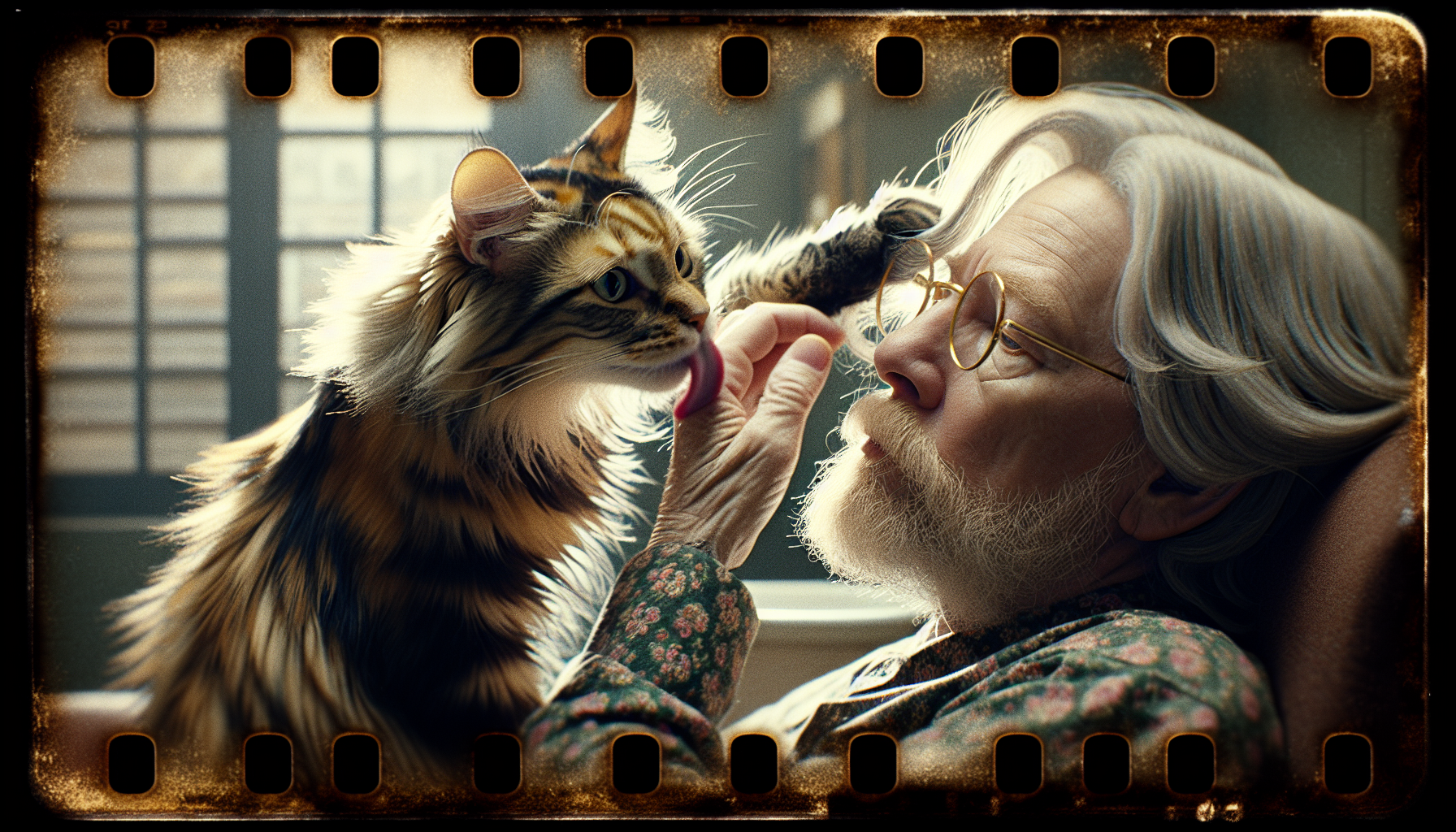Contents
Understanding Your Cat’s Behavior
Cats are fascinating creatures with unique behaviors that can sometimes leave their owners puzzled. Understanding your cat’s behavior is key to building a strong bond with them and ensuring their overall well-being. In this article, we will explore some common cat behaviors and what they might mean.
1. Body Language
One of the primary ways cats communicate is through body language. By paying attention to your cat’s postures and movements, you can gain valuable insights into their mood and intentions. Here are a few common signs to look out for:
– Tail position: A relaxed and slightly curved tail indicates a content and calm cat, while a puffed-up tail suggests fear or aggression.
– Ears: Forward-facing ears indicate a curious or friendly cat, while flattened ears often signal fear or anger.
– Purring: Cats purr when they’re happy and content, but they may also purr when they’re anxious or in pain.
2. Sleeping Patterns
Cats are known for their love of sleep, but their sleeping patterns can sometimes seem puzzling. Understanding why cats sleep the way they do can help you provide them with the appropriate environment for rest. Here’s what you need to know:
– Cats sleep for an average of 12-16 hours a day, with short bursts of high-energy activity in between.
– They are crepuscular animals, meaning they are most active during dawn and dusk.
– Providing your cat with a comfortable and quiet space for napping is essential for their well-being.
3. Play Behavior
Play is an important part of a cat’s life, and it serves multiple purposes. Not only does play provide exercise and mental stimulation, but it also helps cats practice their hunting skills. Here are some key aspects of cat play behavior:
– Stalking and pouncing: Cats are natural hunters, and they often mimic these behaviors during playtime.
– Interactive toys: Engaging your cat with interactive toys helps prevent boredom and encourages exercise.
– Scratching: Scratching is a normal behavior for cats, and providing them with appropriate scratching posts can help save your furniture.
4. Vocalizations
Cats are not the most vocal of pets, but they do communicate through various sounds. Understanding their vocalizations can give you valuable insights into their needs and emotions. Here are a few common cat sounds and what they might mean:
– Meowing: Cats use meowing to communicate with humans, often signaling their desire for attention, food, or comfort.
– Purring: A cat’s purr usually signifies contentment, but it can also indicate they are anxious or seeking reassurance.
– Hissing: Hissing is a defensive sound cats make when they feel threatened or scared.
5. Litter Box Behavior
Proper litter box behavior is essential for a happy cohabitation with your feline friend. Understanding why cats may start exhibiting litter box problems can help you address these issues promptly. Here are some common reasons for litter box issues:
– Dirty litter box: Cats are naturally clean animals, and a dirty litter box can deter them from using it.
– Stress or anxiety: Changes in the household or environment can cause litter box problems in some cats.
– Medical issues: Urinary tract infections or other medical conditions can also lead to litter box avoidance.
In conclusion, understanding your cat’s behavior is crucial for creating a harmonious and fulfilling relationship. By paying attention to their body language, sleeping patterns, play behavior, vocalizations, and litter box behavior, you can ensure your cat’s well-being and happiness. Remember, each cat is unique, so it’s important to observe and learn about your specific feline companion.
Why Do Cats Lick Their Owners?
Cats are known for their grooming habits, and one common behavior that often surprises their owners is their tendency to lick them. While it may seem strange or even unpleasant to some, there are several reasons why cats engage in this behavior. In this article, we will explore the reasons behind why cats lick their owners.
Form of Social Bonding
Licking is a behavior commonly associated with social bonding in cats. When a cat licks their owner, they are essentially grooming them as they would groom themselves or their fellow feline companions. This behavior helps to strengthen the bond between the cat and their owner, creating a sense of trust and comfort.
To encourage this behavior, it’s important for owners to provide their cats with a safe and comforting environment. Spending quality time together, petting them gently, and providing them with affectionate attention can all contribute to a stronger bond and increased licking behavior.
Marking Territory
Cats have scent glands on their tongues, and when they lick their owners, they are actually marking them with their scent. This is a way for cats to establish their territory and claim their owners as part of their social group. By leaving their scent on their owners, cats are communicating to other animals that this human is part of their family.
Additionally, cats often have a strong sense of smell and can detect scents that are imperceptible to humans. By licking their owners, cats can gather valuable information about their surroundings, including the presence of other animals or changes in their owner’s scent, which can help them feel more secure.
Showing Affection and Care
One of the most common reasons why cats lick their owners is to show affection and care. Licking is a nurturing behavior that cats typically reserve for their offspring or other cats they consider part of their family. By licking their owners, cats are displaying their love and care, similar to how a mother would groom her kittens.
When a cat licks their owner, they are also providing a form of grooming. Cats have rough tongues that act like natural brushes, helping to remove dirt, debris, and loose hair from their owner’s skin and fur. This grooming behavior not only keeps the cat’s coat clean but also helps to strengthen their bond with their owner.
Health and Hygiene
Cats are meticulous when it comes to grooming themselves, and when they lick their owners, they are extending their hygiene habits. Cats may be drawn to areas on their owner’s body that they perceive as needing grooming or attention, such as a wound or an area with an unusual scent.
While occasional licking from your cat can be a loving gesture, excessive licking can be a sign of underlying health issues or anxiety. If you notice your cat excessively licking themselves or you, it’s important to consult with a veterinarian to rule out any medical conditions or address any behavioral concerns.
Cats are unique creatures with their own ways of expressing love and affection. Licking their owners is just one behavior they use to communicate and strengthen their bond. Whether it’s to establish territory, show affection, or help with grooming, cats have their reasons for engaging in this behavior. Embracing and understanding this behavior can help foster a stronger relationship between cats and their owners.
The Subtle Clues Hidden in Your Cat’s Licking Behavior
Why Do Cats Lick Themselves?
Cats are notorious for their grooming habits, spending a significant amount of time licking their fur. While grooming is essential for maintaining cleanliness and removing dead hair, it also serves other purposes. Understanding the reasons behind your cat’s licking behavior can provide valuable insights into their overall health and well-being.
Self-Soothing and Stress Relief
Licking can be a form of self-soothing for cats, similar to how humans might engage in behaviors like nail-biting or hair twirling when feeling anxious or stressed. If you notice your cat excessively licking themselves, it could be a sign of underlying stress or anxiety. Identifying and alleviating the source of their distress is crucial for their overall happiness and health.
Social Bonding and Scent Marking
Cats have scent glands on their tongues and paws, which they use to spread their unique scent when grooming. This behavior helps them establish a sense of familiarity and belonging within their territory. If you have multiple cats, you might observe them grooming each other as a way of reinforcing their social bond and showing trust. It’s their way of saying, “You’re part of my family.”
Pain, Discomfort, or Irritation
Excessive licking and grooming can be a sign that your cat is experiencing pain, discomfort, or irritation. Cats may instinctively lick areas that are causing them discomfort, such as wounds, skin allergies, or itchy spots. If you notice persistent licking in a specific area, it’s essential to examine your cat for any signs of injury or underlying medical conditions. Consulting with a veterinarian is highly recommended.
Possible Obsessive-Compulsive Behavior
In some cases, excessive licking can be a sign of obsessive-compulsive disorder (OCD) in cats. OCD in cats is characterized by repetitive and ritualistic behaviors that serve no apparent purpose. If you notice your cat excessively grooming themselves to the point of causing bald patches or skin irritation, it’s essential to consult with a veterinarian or a veterinary behaviorist for a proper diagnosis and treatment plan.
How to Address Excessive Licking
If you suspect that your cat’s licking behavior is excessive or abnormal, it’s important to address the underlying cause. Here are a few steps you can take:
1. Observe: Take note of when and where your cat is licking themselves excessively. Document any changes in their behavior or environment that may be contributing factors.
2. Address stressors: Identify and address any potential sources of stress or anxiety in your cat’s environment. This could include changes in household routines, new pets, or loud noises.
3. Consult a veterinarian: If you’re concerned about your cat’s licking behavior, consult with a veterinarian to rule out any underlying medical conditions or behavioral issues.
4. Provide mental and physical stimulation: Ensure your cat has plenty of interactive toys, scratching posts, and opportunities for play to keep them mentally stimulated and physically active.
5. Consider environmental enrichment: Provide a stimulating environment for your cat with perches, hiding spots, and opportunities for exploration.
6. Use deterrents: If your cat’s excessive licking is causing harm, such as self-inflicted wounds, your veterinarian may suggest using deterrents, such as bitter sprays or Elizabethan collars, to prevent further damage.
Remember, every cat is unique, and their licking behavior can vary. By paying attention to their grooming habits and addressing any concerns, you can ensure that your feline companion stays healthy and happy.
In conclusion, understanding the subtle clues hidden in your cat’s licking behavior can help you decipher their needs and address any underlying issues. Whether it’s a simple grooming routine, social bonding, or a sign of distress, being an attentive and caring cat owner is essential for their overall well-being.
What Your Cat’s Licking Habits Reveal About Their Well-being
As cat owners, we marvel at the elegance and finesse of our feline friends. One behavior that never fails to fascinate us is their grooming ritual – the graceful and meticulous act of licking themselves clean. But did you know that your cat’s licking habits can actually reveal important insights into their well-being? Let’s delve deeper into the world of feline grooming and what it can tell us about our furry companions.
1. Overall Health and Hygiene
A well-groomed cat is a healthy cat. Regular grooming not only helps to keep your cat’s fur soft and shiny, but it also plays a vital role in maintaining their overall health. Cats lick themselves to remove dirt, debris, and excess oil from their fur. It also stimulates blood circulation and aids in regulating body temperature.
If you notice that your cat’s grooming habits have changed, it could be a sign that something is amiss. Excessive licking or the development of bald patches may indicate an underlying health issue like allergies, fleas, or even anxiety. Consulting with your veterinarian can help you identify and address any concerns before they escalate.
2. Social Bonding and Stress Relief
Cats are born with a natural instinct to groom themselves, but grooming is not solely a self-care ritual. Licking is also an integral part of social bonding and communication among cats. When cats groom each other, they are not only engaging in mutual hygiene but also reinforcing social bonds.
Similarly, when your cat licks you, it’s their way of showing affection, trust, and acceptance. This behavior is particularly evident in young kittens who lick their mother as a way of seeking comfort and nourishment.
Furthermore, licking also serves as a stress-relief mechanism for cats. Just like humans find solace in activities like yoga or meditation, cats turn to grooming to calm themselves. Regular grooming sessions, whether self-directed or social, can help reduce stress levels and promote emotional well-being in your feline companion.
3. Tell-Tale Signs of Pain or Discomfort
Cats are masters at hiding pain and discomfort, often making it challenging for owners to identify when something is wrong. However, changes in their licking behavior can provide valuable clues.
If you notice that your cat has suddenly started obsessively licking a specific area of their body, it could be a sign of an underlying issue, such as a wound, injury, or skin irritation. Over-grooming in one spot often leads to hair loss, redness, or even open sores.
Paying close attention to your cat’s licking habits can help you spot potential problems early on and seek the necessary veterinary care. Remember, prevention is always better than cure.
Understanding your cat’s licking habits can provide valuable insights into their overall well-being. Regular and healthy grooming habits indicate a happy and content cat, while sudden changes may indicate underlying health issues or emotional distress. By paying attention to these grooming behaviors, we can better care for our feline companions and ensure their ongoing health and happiness.





